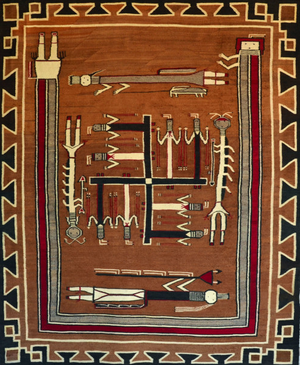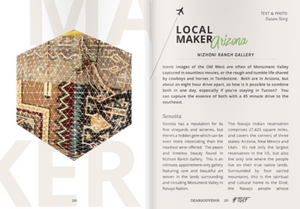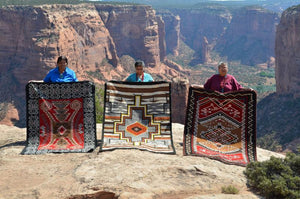Nizhoni Ranch News

The History of Creating Vegetal Rug Dyes
 Weavers have been dyeing the wool for their weavings to create beautiful artistry nearly as long as they’ve been making rugs, tapestries, throws and blankets. And while methods have varied over the years, early Navajo weavers began using natural plant dyes as far back as the 1700s.
Weavers have been dyeing the wool for their weavings to create beautiful artistry nearly as long as they’ve been making rugs, tapestries, throws and blankets. And while methods have varied over the years, early Navajo weavers began using natural plant dyes as far back as the 1700s.
Back then, wool was often dyed using indigo (blue) and cochineal (red)—which was sourced from the English Bayetta wool. Weavers continued to expand their dyeing abilities by boiling plants and extracting even more lasting colors and earthy tones. Today, weavers use a variety of beautiful colors to create gorgeous weavings that are simply breathtaking.
 Vegetal Dyes
Vegetal Dyes
Traditional vegetal dye-making can be a difficult process, especially when trying to achieve the right consistency during dyeing. Weavers use a variety of natural sources to get the right hues and colorations, including roots, berries, flowers, leaves, moss, bark, and even seeds, all of which will vary depending on the growing season.
A fun fact about vegetal dyes: Vegetal dye creation wasn’t an “original” Navajo tradition. The revival of the vegetal dyed blanket began in the 1920s in Chinle with Cozy McSparren and later, Don Jenson in the 1940s. Bill and Sally Lippincott, owners of the Wide Ruins Trading Post, encouraged weavers to use vegetal and native dyes in the 1930s.
By the 1950s, legendary weaver Mable Burnside-Myers of Pine Springs, AZ, created a Navajo Dye Chart to help her children and other weavers create more consistent colors. Her chart shows the following native plants and sources:
- Red Onion Skin
- Sunflower
- Alder Bark
- Sagebrush
- Indian Paint Brush
- Rubber Plant
- Juniper Mistletoe
- Rose Hips
- Small Snake Weed
- Juniper Bark
- Brown Onion Skin
- Gamble Oak Bark
 This resurgence in using native reservation plants has played a major factor in the quality and value of rugs today. In fact, because producing consistent colors and having enough resources can make vegetal dye rugs can be a challenge, the cost of these memorable pieces will continue to rise.
This resurgence in using native reservation plants has played a major factor in the quality and value of rugs today. In fact, because producing consistent colors and having enough resources can make vegetal dye rugs can be a challenge, the cost of these memorable pieces will continue to rise.
Other Notable Dyes and Color Additions
though vegetal dyes are the most widely used and valued among the dyeing formats, there are also two other dyes that should be mentioned so you can properly understand how weavings are colored. These are aniline dyes and blended wools.
Aniline Dye
A synthetic and organic class of dye sourced from coal tar (aniline), these dyes or pigments are generally found in very bright or very dark colors used in Navajo weavings or textiles. Even newer anilines are working to emulate the subtle tones of vegetal dyes.
Blended Wools
When weavers card natural sheep wools and goat fibers together, this can form a new natural color known as a blended wool. For example, if you were to take two different sheep colors (black and white), you could card them together to create soft grays. These are often found in hand-spun rugs.
- jamie getzwiller

Symbols and Motifs in Navajo Weaving
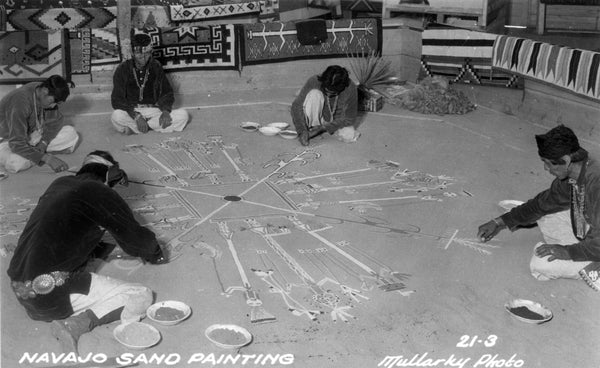 The Navajo people have a rich history of beautiful traditions that are proudly passed down from generation to generation; many of which can be seen in the gorgeous weavings and tapestries of the Navajo weavers.
The Navajo people have a rich history of beautiful traditions that are proudly passed down from generation to generation; many of which can be seen in the gorgeous weavings and tapestries of the Navajo weavers.
Like most storied cultures, the Navajo believe in powerful deities and forces that have guided them on their path through life; be it traveling by the sun’s rays, learning to live in harmony by Changing Woman, or building a framework for life by using the teachings of Spider Woman.
As such, there are a few very distinct designs, patterns, and motifs that can be found in both past and present weaving styles. Below are just a few of the more iconic and storied traditions used by weavers young and old.
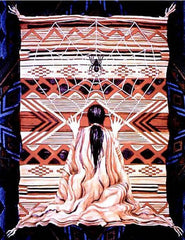 Spider Woman
Spider Woman
Being that Spider Woman taught the Navajo how to weave, it’s only fitting she dominates much of the early weaving work done by the Navajo people. That’s why many early blankets featured a cross representing Spider Woman and her teachings. Though methods on placement vary, it’s widely considered taboo to place this cross within a diamond, square or triangle pattern so as not to “trap” her in the work; thus, you’ll often find a hole (figuratively or legitimately) woven into the piece.
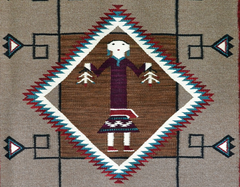 Navajo Homeland
Navajo Homeland
Navajo weavers, like anyone proud of their motherland, would often capture elements of the four sacred mountains of the Navajo homeland in their work. From wearing blankets to modern-day rugs, the use of diamonds and triangles have become cornerstones for representing the “Dinétah” and the beautiful land they call home.
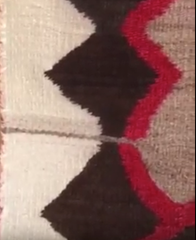 Spirit Line
Spirit Line
At the turn of the 20th century, weavers began to popularize what we now know as the “spirit line.” This developed because traders of the era wanted borders around these weavings and the Navajo weavers were worried this style would trap their creativity and limit the future work. The spirit line then became a thin contrasting line that ran from the inner weaving to the outer edge to ensure that the creative spirit could still be found.
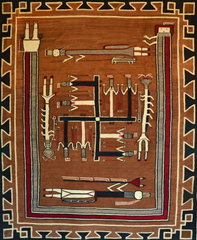 Whirling Logs
Whirling Logs
One of the most iconic (and controversial) design elements up until the 1930's was the whirling logs design. Often mistaken for the Nazi “swastika”, the logs were originally chosen as a symbol of good luck and represented all things good to the Navajo. As you can imagine, this style didn’t prevail through WWII.
 Lightning
Lightning
A powerful elemental force symbolizing much among the Navajo people, lightning embodies strength and power for the weaver, the culture, and even the weaving itself. These “zigzag” weaving styles are most often found in the Eye Dazzler and Germantown designs, creating gorgeous designs that give each rug or blanket its own fantastic energy.
Other Notable Inspirations
Like many early civilizations, the Navajo weavers were inspired by their unforgettable pasts. Weavers would often find inspiration in pictographs, prehistoric pottery, petroglyphs, and even the natural color palettes around them.
- jamie getzwiller

- Brad Rees
- Tags: News

Picturesque Canyon de Chelly
|
- Brad Rees
- Tags: News




